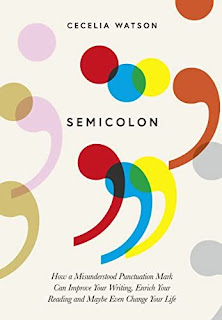Watson, Cecelia. Semicolon: The Past, Present, and Future of a Misunderstood Mark New York: HarperCollins 2019. Print.
"The semicolon has become so hateful to me," confessed Paul Robinson in a New Republic essay, "that I fell almost morally compromised when I use it."
Description:
... reformed grammar fetishist myself, the sort of person who used to feel that her love for English was best expressed by means of irritation at the sight of a misplaced apostrophe, or outright heart palpitations over a comma splice.
To settle for herself an argument with her PhD advisor about the proper use of the semicolon, she imersed herself in a 10-year quest to understand where the rules of grammar came from.
[I searched] through piles of dusty grammar books that had lain untouched on library shelves for decades, and more often centuries. Some, having been forgotten for so long, collapsed in my hands; others left my palms tinted a guilty red with rot from their decaying leather bindings. [Note her proper use of the semicolon here and throughout this book.]
What she found was amazingly interesting to me. She discovered that grammar books, the original sources for a wide variety of rules, were attempts by writers to solidify their own rules as THE ONLY rules for everyone to employ (and, of course, to sell their own language books).
Codified grammar as a set of rules countered this prevalent belief and tried to champion punctuation consistency. These rules of language were considered a worthwhile subject for classroom study and book writing as a vital technique to "scientize" language. Parents and school officials, at that time, demanded children study only scientific topics which were based on knowledge and facts, rather than contradictory opinions about language and punctuation usage.
Any good science textbook had diagrams, and if grammar was to be a science, it surely needed a system of schematic illustrations as well. And so, in 1847, a grammarian named Stephen Clark introduced a system of diagrams designed to relate to the "Science of Language" as maps did to geopraphy, and figures to geometry and arithmetic.
Now to
answer your burning question, the semicolon was first used in 1494 by
Aldua Manutius, a printer and publisher, who created the semicolon and
inserted it into the essay, De Aetna (about climbing Mt. Etna), to help readers know when to pause and hopefully understand long sentences better.
Watson fills Semicolon with many delightful (to me!) examples of the semicolon's impact on history. From the 1900 Massachusetts Supreme Court ruling on which hours local inns could serve alcohol, to the 1927 ruling of two convicted murders to execute one man and only imprison for life the other, all due to the placement of a semicolon in the laws.
She offers the opinions and writing examples from Raymond Chandler (in The Big Sleep), Daniel Defoe (Robinson Caruso), Herman Melville (Moby-Dick), Henry James (Portrait of a Lady), and Junot Diaz (The Brief Wonderous Life of Oscar Wao) among others. The most powerful use of the semicolon Watson shares is from Martin Luther King's Letters from Birmingham Jail:
Perhaps it is easy for those who have never felt the stinging darts of segregation to say, "Wait." But when you have seen vicious mobs lynch your mothers and fathers at will and drown your sisters and brothers at whim; when you have seen hate filled policemen curse, kick, and even kill your black brothers and sisters; when you see the vast majority of your twenty million Negro brothers smothering in an airtight cage of poverty in the midst of an affluent society....
So grammar and particularly the semicolon rise to a place of acceptance and importance through Watson's book of grammatical history, all thanks to the people who made grammar a scientific subject with rules instead of merely the whims of individuals.
If you enjoy reading about history and the impact of seemingly minor players throughout the ages and in the present, then Semicolon is for you. It certainly was an enjoyable experience reading for me.
Happy reading.
Fred
The definitive grammar style guide: brief, funny, and so wonderfully readable. Highly recommended for grammar enthusiasts or anyone who want to write in the most professional, clear manner.
